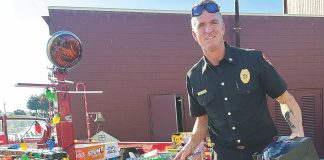By JOHANNA MILLER
Last month, I took a trip to San Francisco to visit my friend, Holly, who had recently moved to the city from Oregon. We had met during college and were looking forward to a weekend of catching up and sight-seeing.
A near-accident in the middle of the trip ended up putting quite a damper on our mood.
Anyone familiar with the Sunset District of San Francisco knows how bad 19th Avenue can be for backed-up traffic, which often stretches all the way from Golden Gate Park to Interstate 280 in the afternoon. People often succumb to road-rage on this strip of street, impatient and frustrated at the slow pace.
Holly and I had been inching along in said traffic for about 15 minutes when I noticed an opening to change lanes. Flicking on my turn signal, I checked my side mirror and began to move.
That’s when a speed bike suddenly appeared — shooting through the middle of the lanes and straight toward me.
I slammed on my brakes. Thankfully, there was enough space for the motorcyclist to swerve into the adjacent lane — and then automatically hop back into the middle. I’m not sure they even slowed down.
After recovering from the shock, Holly and I launched into a discussion about this practice. Was it even legal? Were there any kinds of rules? We decided to investigate.
What we read on the official State of California Department of Motor Vehicles website ended up confusing us even further. It states that previous lane splitting guidelines had been taken down after a petitioner complained about the lack of an official “rule-making process.”
And then, this line follows:
“California law does not allow or prohibit motorcycles from passing other vehicles proceeding in the same direction within the same lane, a practice often called ‘lane splitting,’ ‘lane sharing’ or ‘filtering.’”
The words “allow” and “prohibit” are antonyms. So, lane splitting in California is both allowed and also … not?
During a recent media ride-along with CHP officer Julieta Trenado, I brought up the issue. She did her best explaining to me the guidelines most CHP officials follow.
“Lane splitting is technically legal,” she said. “But only when everyone is going close to the same speed. When motorcyclists speed through stalled traffic like that — that’s when we will take action.”
With the amount of traffic that residents in this region deal with on a daily basis, particularly during the summer months, it’s no surprise that motorcyclists would want to use their compactness to their advantage.
But it’s gotten to a point where I can’t go a month without experiencing or witnessing a near-accident because of lane splitting.
“It puts everyone, especially the motorcyclists, at a much higher risk,” Trenado said. “We really don’t recommend it.”
In my opinion, it comes down to using common sense. As a driver of a small Subaru Impreza, I am on constant lookout for large vehicles that might not be able to see me — raised trucks, big rigs, buses. Motorcyclists should be exercising just as much, if not more, caution.
And if drivers won’t change their behavior, perhaps the law should step in once again — either setting some sort of official, government-mandated rule about lane splitting or at least trying to better educate people on the issue.
Sharing the road is one thing, doing so safely is another. Let’s work on that.
•••
Johanna Miller can be reached at 761-7303 or jm*****@********an.com.













